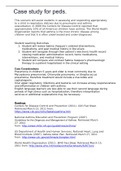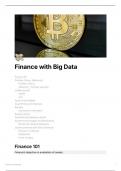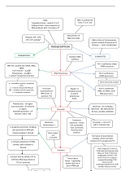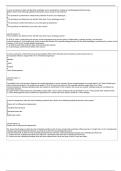Text Book Notes
Chapter 1 - Influence
Peoples influence are positively influenced by others
Advertising: call the attention or to notify or warn people of something by means of
announcement in a public medium
Analysis by Owen Gibson (2005): he attached a camera to his glasses and went to public
transport. Based upon experiments, he found that he recognized half of the brand in which he
was interested in
We night not recall many of the messages we see, but we do often recognize them
A brief history of influence research
The greeks were interested in eloquence and art of persuasion:
a. Plato believed they were not interested in the truth
b. Aristotle approached process of persuasion and founder of argumentation theories
i.
1. Consider public you are addressing and concentrate in those aspects
1. Attitudes
Emphasis on:
1. Linguistic aspect
a. When message influences attitude and behaviour
2. Process involved in persuasion
a. How message influences attitude and behaviour
Lasswell: “who says what in which channel to whom, with what effect”
,→ Lasswell studied effectiveness of propaganda in the 1940s - Attitude
Attitude: evaluative response - positive or negative - to a person, a situation, a product, or a message.
Peoples evaluative response to stimulus, or attitude object
Yale model: is limited → it asserts only that motivated people
2. Advertising and influence
One of the earliest models in marketing and advertising to understand how to influence is the AIDA(S)
model
Attention
Interest
Desire
Action
Extended Satisfaction example in customer loyalty
Influence and ethics
Two extreme standpoints (Perloss, 2010):
1. Rejection of sophists’ rhetoric (plato)
2. People are free to do what they wish with information they receive and ethical (without
force) → difficult to uphold
Subconscious influence: advertising messages they are not aware of
,Example Vacary (1957) claimed magazine “advertising age” that he used special “invisible”
technique during film with “drink coca-cola” and “eat popcorn”
“All attitudes change is the result of conscious processes” is WRONG
Chapter 2 - Attitudes and Behaviour
How people are influences → what we want that influence to achieve objective influence
Attitudes, attitude formation, and behaviour
Attitude is not directly observable
Attitudes as a latent construct:
Latent construct: they cannot be observed directly and therefore cannot be measured directly
Components of attitude:
1. Cognitions (beliefs, opinions)
2. Affect (feelings, emotions)
3. Behaviour (actions, conduct)
Cognitive response: thoughts aroused by particular characteristics of the attitude object, on
the basis of which we form an evaluative judgement about it (+/-)
Affective response: feelings, sentiments, or emotions an attitude object elicits. They can be
expressed through verbal and non-verbal communication
Behavioral response: they are the manifests of evaluation, such as consumer buying habits
and interpersonal habits. They are the consequence of an attitude towards which both cognitive
and affective reactions have contributed
, 5 characteristics of attitude:
1. They focus on an object, person, organization, or event
2. They are evaluative (+/-)
3. They can be based on cognitive beliefs about characteristics of the attitude object
4. They can be based in affective response to the attitude object
5. They have repercussions for behaviour towards attitude objects
Affective responses are better predictors of intentions to act, especially in health behaviour
Reasoned and intuitive attitudes
The dual process model tried to evaluative between careful information processing and
superficial equivalent
The elaboration likelihood model says that there are 2 ways to process information/attitude can
be modified:
1. High degree of thought
2. Low degree of though
Petty and Caccioppo
Example doctor makes exams and explains the consequences. Then you start asking a lot of
info → central route
1. ELM
ELM = central route to persuasion and peripheral route to persuasion
Central route to persuasion: attitudes are formed or modified after thorough consideration and
analysis of the core characteristics of the attitude object
Peripheral route to persuasion: attitudes are formed by drawing on characteristics of the
attitude object or the situation, such as the source of the information, which are only indirectly
relevant for the issue at hand
Chapter 1 - Influence
Peoples influence are positively influenced by others
Advertising: call the attention or to notify or warn people of something by means of
announcement in a public medium
Analysis by Owen Gibson (2005): he attached a camera to his glasses and went to public
transport. Based upon experiments, he found that he recognized half of the brand in which he
was interested in
We night not recall many of the messages we see, but we do often recognize them
A brief history of influence research
The greeks were interested in eloquence and art of persuasion:
a. Plato believed they were not interested in the truth
b. Aristotle approached process of persuasion and founder of argumentation theories
i.
1. Consider public you are addressing and concentrate in those aspects
1. Attitudes
Emphasis on:
1. Linguistic aspect
a. When message influences attitude and behaviour
2. Process involved in persuasion
a. How message influences attitude and behaviour
Lasswell: “who says what in which channel to whom, with what effect”
,→ Lasswell studied effectiveness of propaganda in the 1940s - Attitude
Attitude: evaluative response - positive or negative - to a person, a situation, a product, or a message.
Peoples evaluative response to stimulus, or attitude object
Yale model: is limited → it asserts only that motivated people
2. Advertising and influence
One of the earliest models in marketing and advertising to understand how to influence is the AIDA(S)
model
Attention
Interest
Desire
Action
Extended Satisfaction example in customer loyalty
Influence and ethics
Two extreme standpoints (Perloss, 2010):
1. Rejection of sophists’ rhetoric (plato)
2. People are free to do what they wish with information they receive and ethical (without
force) → difficult to uphold
Subconscious influence: advertising messages they are not aware of
,Example Vacary (1957) claimed magazine “advertising age” that he used special “invisible”
technique during film with “drink coca-cola” and “eat popcorn”
“All attitudes change is the result of conscious processes” is WRONG
Chapter 2 - Attitudes and Behaviour
How people are influences → what we want that influence to achieve objective influence
Attitudes, attitude formation, and behaviour
Attitude is not directly observable
Attitudes as a latent construct:
Latent construct: they cannot be observed directly and therefore cannot be measured directly
Components of attitude:
1. Cognitions (beliefs, opinions)
2. Affect (feelings, emotions)
3. Behaviour (actions, conduct)
Cognitive response: thoughts aroused by particular characteristics of the attitude object, on
the basis of which we form an evaluative judgement about it (+/-)
Affective response: feelings, sentiments, or emotions an attitude object elicits. They can be
expressed through verbal and non-verbal communication
Behavioral response: they are the manifests of evaluation, such as consumer buying habits
and interpersonal habits. They are the consequence of an attitude towards which both cognitive
and affective reactions have contributed
, 5 characteristics of attitude:
1. They focus on an object, person, organization, or event
2. They are evaluative (+/-)
3. They can be based on cognitive beliefs about characteristics of the attitude object
4. They can be based in affective response to the attitude object
5. They have repercussions for behaviour towards attitude objects
Affective responses are better predictors of intentions to act, especially in health behaviour
Reasoned and intuitive attitudes
The dual process model tried to evaluative between careful information processing and
superficial equivalent
The elaboration likelihood model says that there are 2 ways to process information/attitude can
be modified:
1. High degree of thought
2. Low degree of though
Petty and Caccioppo
Example doctor makes exams and explains the consequences. Then you start asking a lot of
info → central route
1. ELM
ELM = central route to persuasion and peripheral route to persuasion
Central route to persuasion: attitudes are formed or modified after thorough consideration and
analysis of the core characteristics of the attitude object
Peripheral route to persuasion: attitudes are formed by drawing on characteristics of the
attitude object or the situation, such as the source of the information, which are only indirectly
relevant for the issue at hand











